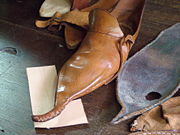
Poulaine
Encyclopedia

Shoe
A shoe is an item of footwear intended to protect and comfort the human foot while doing various activities. Shoes are also used as an item of decoration. The design of shoes has varied enormously through time and from culture to culture, with appearance originally being tied to function...
s with extremely long toes very popular in the 15th century. They were so named because the style was thought to have originated in Kraków
Kraków
Kraków also Krakow, or Cracow , is the second largest and one of the oldest cities in Poland. Situated on the Vistula River in the Lesser Poland region, the city dates back to the 7th century. Kraków has traditionally been one of the leading centres of Polish academic, cultural, and artistic life...
, then the capital of Poland
Poland
Poland , officially the Republic of Poland , is a country in Central Europe bordered by Germany to the west; the Czech Republic and Slovakia to the south; Ukraine, Belarus and Lithuania to the east; and the Baltic Sea and Kaliningrad Oblast, a Russian exclave, to the north...
. They began in the late 14th century and fell from fashion after about 1480–90. They were worn by men and women, but men's were the most extravagantly long.
Sometimes the point of the shoe (known as the "poulaine" ) would need support from a whalebone
Baleen
Baleen or whalebone is a filter-feeder system inside the mouths of baleen whales. The baleen system works when a whale opens its mouth underwater and then water pours into the whale's mouth. The whale then pushes the water out, and animals such as krill are filtered by the baleen and remain as food...
or a string tied to the leg (just below the knee) to stop the point getting in the way when walking. (Examples from medieval London have the points stuffed with moss
Moss
Mosses are small, soft plants that are typically 1–10 cm tall, though some species are much larger. They commonly grow close together in clumps or mats in damp or shady locations. They do not have flowers or seeds, and their simple leaves cover the thin wiry stems...
.) Outdoors pattens or sandal-like clogs were usually worn underneath.
The Pope
Pope
The Pope is the Bishop of Rome, a position that makes him the leader of the worldwide Catholic Church . In the Catholic Church, the Pope is regarded as the successor of Saint Peter, the Apostle...
and the King Henry IV of England
Henry IV of England
Henry IV was King of England and Lord of Ireland . He was the ninth King of England of the House of Plantagenet and also asserted his grandfather's claim to the title King of France. He was born at Bolingbroke Castle in Lincolnshire, hence his other name, Henry Bolingbroke...
tried to stop this practice. The antiquarian John Stow
John Stow
John Stow was an English historian and antiquarian.-Early life:The son of Thomas Stow, a tallow-chandler, he was born about 1525 in London, in the parish of St Michael, Cornhill. His father's whole rent for his house and garden was only 6s. 6d. a year, and Stow in his youth fetched milk every...
wrote at the end of the
16th century that:

Richard II of England
Richard II was King of England, a member of the House of Plantagenet and the last of its main-line kings. He ruled from 1377 until he was deposed in 1399. Richard was a son of Edward, the Black Prince, and was born during the reign of his grandfather, Edward III...
married Anne of Bohemia
Anne of Bohemia
Anne of Bohemia was Queen of England as the first wife of King Richard II. A member of the House of Luxembourg, she was the eldest daughter of Charles IV, Holy Roman Emperor, and Elizabeth of Pomerania....
in 1382, and "the fourth of Edward IV" is 1475, when the fashion was at its peak. The tying back to the leg is however rarely seen in the art of the period — it may have been something done when moving around, with the ties removed on arrival, or the prevalence of the habit may be exaggerated by censorious commentators.
Other sumptuary law
Sumptuary law
Sumptuary laws are laws that attempt to regulate habits of consumption. Black's Law Dictionary defines them as "Laws made for the purpose of restraining luxury or extravagance, particularly against inordinate expenditures in the matter of apparel, food, furniture, etc." Traditionally, they were...
s attempted to define by class how long shoes could be - the nobility were to be allowed two foot-lengths, merchants one, and peasants one half. Like other attempts to control fashion by legislation, these seem to have failed.
At the Battle of Nicopolis
Battle of Nicopolis
The Battle of Nicopolis took place on 25 September 1396 and resulted in the rout of an allied army of Hungarian, Wallachian, French, Burgundian, German and assorted troops at the hands of an Ottoman force, raising of the siege of the Danubian fortress of Nicopolis and leading to the end of the...
in 1396, French Crusaders were forced to cut off the tips of their poulaines in order to be able to run away.
See also
- Venetian style shoeVenetian style shoeVenetian style shoes are mid-heel slippers with an upper or top part that is slightly open to the kick of the foot and the ankle bone. The slipper is comparable to the profile and style of a Venetian bark...
- Curious history of long-toed shoes

